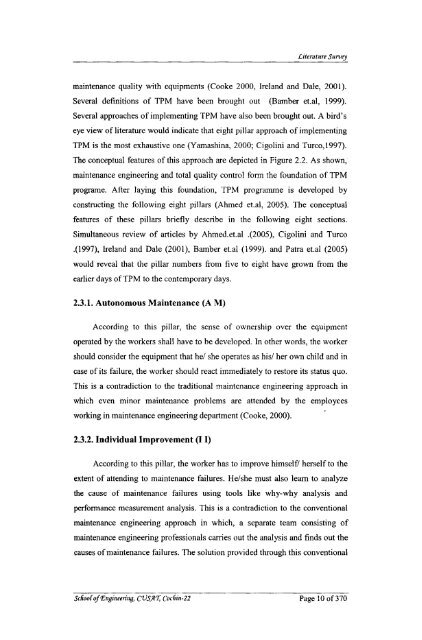MQFD: A Model for Synergizing TPM and QFD - Cochin University of ...
MQFD: A Model for Synergizing TPM and QFD - Cochin University of ...
MQFD: A Model for Synergizing TPM and QFD - Cochin University of ...
Create successful ePaper yourself
Turn your PDF publications into a flip-book with our unique Google optimized e-Paper software.
Literature SUT'lJey<br />
maintenance quality with equipments (Cooke 2000, Irel<strong>and</strong> <strong>and</strong> Dale, 2001).<br />
Several definitions <strong>of</strong> <strong>TPM</strong> have been brought out (Bamber et.al, 1999).<br />
Several approaches <strong>of</strong> implementing <strong>TPM</strong> have also been brought out. A bird's<br />
eye view <strong>of</strong>literature would indicate that eight pillar approach <strong>of</strong> implementing<br />
<strong>TPM</strong> is the most exhaustive one (Yamashina, 2000; Cigolini <strong>and</strong> Turco,1997).<br />
The conceptual features <strong>of</strong> this approach are depicted in Figure 2.2. As shown,<br />
maintenance engineering <strong>and</strong> total quality control <strong>for</strong>m the foundation <strong>of</strong> <strong>TPM</strong><br />
programe. After laying this foundation, <strong>TPM</strong> programme is developed by<br />
constructing the following eight pillars (Ahmed et.al, 2005). The conceptual<br />
features <strong>of</strong> these pillars briefly describe in the following eight sections.<br />
Simultaneous review <strong>of</strong> articles by Ahmed.et.al .(2005), Cigolini <strong>and</strong> Turco<br />
.(1997), Irel<strong>and</strong> <strong>and</strong> Dale (2001), Bamber et.al (1999). <strong>and</strong> Patra et.al (2005)<br />
would reveal that the pillar numbers from five to eight have grown from the<br />
earlier days <strong>of</strong><strong>TPM</strong> to the contemporary days.<br />
2.3.1. Autonomous Maintenance (A M)<br />
According to this pillar, the sense <strong>of</strong> ownership over the equipment<br />
operated by the workers shall have to be developed. In other words, the worker<br />
should consider the equipment that he/ she operates as his/ her own child <strong>and</strong> in<br />
case <strong>of</strong>its failure, the worker should react immediately to restore its status quo.<br />
This is a contradiction to the traditional maintenance engineering approach in<br />
which even minor maintenance problems are attended by the employees<br />
working in maintenance engineering department (Cooke, 2000).<br />
2.3.2. Individual Improvement (I I)<br />
According to this pillar, the worker has to improve himself/ herself to the<br />
extent <strong>of</strong> attending to maintenance failures. He/she must also learn to analyze<br />
the cause <strong>of</strong> maintenance failures using tools like why-why analysis <strong>and</strong><br />
per<strong>for</strong>mance measurement analysis. This is a contradiction to the conventional<br />
maintenance engineering approach in which, a separate team consisting <strong>of</strong><br />
maintenance engineering pr<strong>of</strong>essionals carries out the analysis <strong>and</strong> finds out the<br />
causes<strong>of</strong>maintenance failures. The solution provided through this conventional<br />
SCho<strong>of</strong><strong>of</strong>tEngineering, CVS)H; Cocfiin-22 Page 10 <strong>of</strong> 370

















